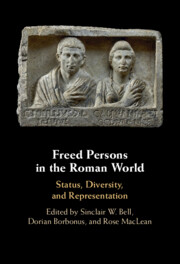Book contents
- Freed Persons in the Roman World
- Freed Persons in the Roman World
- Copyright page
- Contents
- Figures
- Table
- Contributors
- Acknowledgments
- Bibliographical Note
- Introduction
- 1 Permissu decurionum
- 2 Freed Public Slaves in Roman Italy and the Western Provinces
- 3 Fitting in by Decree
- 4 Doubling Up
- 5 The Cost of Ingratitude
- 6 Between Moral Slavery and Legal Freedom
- 7 Framing the Freed Person
- 8 Novel Evidence for Ancient Freed People
- 9 The Affects of Manumission
- General Bibliography
- Index
- References
2 - Freed Public Slaves in Roman Italy and the Western Provinces
Legal Status and Social Integration*
Published online by Cambridge University Press: 16 May 2024
- Freed Persons in the Roman World
- Freed Persons in the Roman World
- Copyright page
- Contents
- Figures
- Table
- Contributors
- Acknowledgments
- Bibliographical Note
- Introduction
- 1 Permissu decurionum
- 2 Freed Public Slaves in Roman Italy and the Western Provinces
- 3 Fitting in by Decree
- 4 Doubling Up
- 5 The Cost of Ingratitude
- 6 Between Moral Slavery and Legal Freedom
- 7 Framing the Freed Person
- 8 Novel Evidence for Ancient Freed People
- 9 The Affects of Manumission
- General Bibliography
- Index
- References
Summary
This chapter focuses on the legal status and social position of public freed persons in the Roman world, with a particular focus on Italy and the western provinces. It primarily aims to test the idea that public slaves enjoyed a better social condition in comparison to other groups of enslaved persons, by investigating their prospects to gain freedom and build social relationships. The first section considers the legal status of public freed persons, by describing the process of their manumission in self-governing towns in the light of chapter 72 of the Lex Irnitana and discussing the related modern debate about the possible condition that was granted to public freed persons in the municipium of Irni, Baetica (cives Latini or Latini Iuniani?). The second section examines whether, how and why public freed persons could integrate into urban society, based on the extant inscriptional evidence in Italy and the western provinces.
Keywords
- Type
- Chapter
- Information
- Freed Persons in the Roman WorldStatus, Diversity, and Representation, pp. 56 - 85Publisher: Cambridge University PressPrint publication year: 2024

